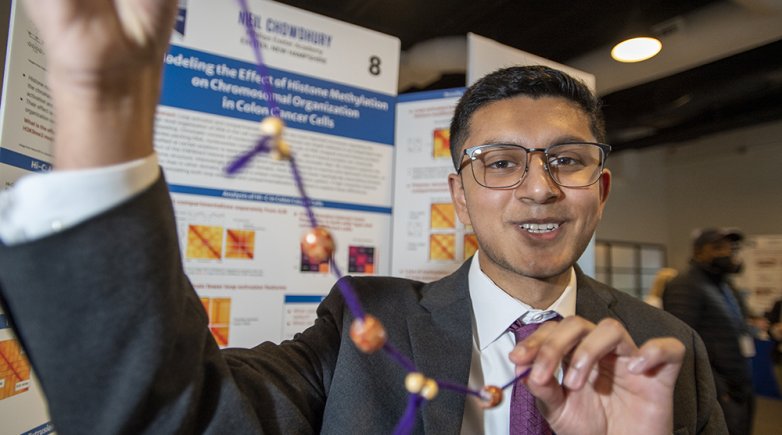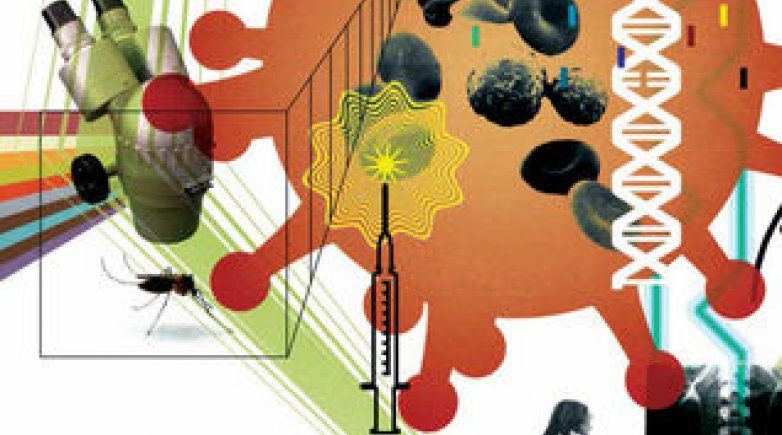Neuroscientist addresses assembly
Any process of transformation — from social change movements to new approaches in medicine — begins with agitation, neuroscience researcher Khalid Shah told students in the Assembly Hall on Friday. “If you want to bring a change, you need to be agitated in your mind, which will lead to the innovation,” Shah said. “That innovation will ultimately be the change.”
As the vice chair of research for the department of neurosurgery and director of The Center for Stem Cell and Translational Immunotherapy at Brigham and Women’s Hospital, Shah leads a team that is pioneering targeted, cell-based therapies for brain cancers. He is also a professor at Harvard Medical School.
Townley Chisholm, instructor in the Science Department, introduced Shah in assembly and welcomed him for a visit to his BIO510: Advanced Biology class earlier on Friday morning. “For over 10 years, [Dr. Shah] has invited groups of students from PEA to visit his lab in Boston and to talk with his researchers…who come from all over the world for the chance to work in his lab on paradigm-shifting ways to use the newest technologies to cure otherwise untreatable cancer.”
About seven or eight years ago, Shah explained in his assembly talk, he and his team began questioning the way doctors were treating glioblastoma, a lethal form of brain cancer. For the past 20 years, the treatment options have remained the same: Patients get surgery to remove the tumor, followed by chemotherapy, radiation or both.
“Although we’ve had a number of clinical trials with different drugs…nothing really has changed,” Shah said. He added that the blood-brain barrier, an additional layer of protective coating on the blood vessels in the brain, also make it more difficult for drugs used to treat cancer to get inside the brain to work effectively.
To challenge the status quo, Shah and his team looked to medical innovations from the past, notably the insights that led to the first safe vaccines to treat previously deadly diseases like smallpox in the 18th century. “It started with something really basic: that we use disease to kill disease,” Shah said.
By design, cancer cells leave the original tumor en masse and metastasize to other parts of the body. But they also tend to migrate back to the original tumor — a feature that is key to Shah’s team’s experimental therapy. Using the powerful gene-editing technology known as CRISPR (Clustered Regularly Interspaced Short Palindromic Repeats), they engineered repurposed cancer cells that seek out and attack cells in the original tumor.
“You make them therapy resistant and then you actually also put a kill switch in it, and it kills the original cell,” Shah said. He used images of vivid red and green cells resembling abstract paintings to illustrate the process on the Assembly Hall stage.
The treatment, known as therapeutic tumor cells (ThTCs) has so far been tested on mice, with positive results. “We see a huge survival benefit in animals, and hopefully in humans in coming years,” Shah said. He and his team have more recently been working on engineering the tumor cells to also include cells that spur an immune response, increasing their disease-fighting potential.
“Once the tumor is gone, you’re vaccinated from further tumors to come — that’s the big picture,” Shah said near the end of his talk, adding that the gut microbiome also plays an important role in the effectiveness of immunotherapy in cancer treatment.
In addition to sharing the thought processes behind his pathbreaking work, Shah offered words of advice — and encouragement — to future scientists in the Assembly Hall audience. He emphasized the value of collaboration, both inside the lab and with scientists of different disciplines: “You need one or two good innovative ideas to make the difference, but…if you don’t have a structure, anything you bring in that is unique [is] not going to go that far.”
“In all of us, there is an innovator lying somewhere,” Shah concluded. “You just have to figure out which domain excites you the most.”
More to explore

The Exeter Bulletin

